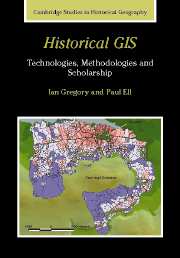Book contents
- Frontmatter
- Contents
- List of figures
- List of tables
- Acknowledgements
- 1 GIS and its role in historical research: an introduction
- 2 GIS: a framework for representing the Earth's surface
- 3 Building historical GIS databases
- 4 Basic approaches to handling data in a historical GIS
- 5 Using GIS to visualise historical data
- 6 Time in historical GIS databases
- 7 Geographic Information Retrieval: historical geographic information on the internet and in digital libraries
- 8 GIS and quantitative spatial analysis
- 9 From techniques to knowledge: historical GIS in practice
- References
- Index
7 - Geographic Information Retrieval: historical geographic information on the internet and in digital libraries
Published online by Cambridge University Press: 23 June 2009
- Frontmatter
- Contents
- List of figures
- List of tables
- Acknowledgements
- 1 GIS and its role in historical research: an introduction
- 2 GIS: a framework for representing the Earth's surface
- 3 Building historical GIS databases
- 4 Basic approaches to handling data in a historical GIS
- 5 Using GIS to visualise historical data
- 6 Time in historical GIS databases
- 7 Geographic Information Retrieval: historical geographic information on the internet and in digital libraries
- 8 GIS and quantitative spatial analysis
- 9 From techniques to knowledge: historical GIS in practice
- References
- Index
Summary
7.1 INTRODUCTION
So far, this book has been concerned with the overlap between two very different sub-disciplines: historical geography and GIS. In this chapter, a third subject is used extensively: library science. Large digital libraries and the internet have the potential to make data available to historians in volumes that are still difficult to imagine. A major problem that this will inevitably lead to is simply finding relevant data. If a user is interested in a particular place, then clearly GIS has a role to play in helping to find information about that place. Library science has experience in designing catalogues and, more recently, search engines that allow users to find the resources they require. Adding searching by place requires the use of locational information, either in the form of co-ordinates, or as place names, or both. This requires an overlap between GIS and library science that has led to a growing inter-disciplinary field, sometimes known as Geographical Information Retrieval (GIR) (Larson, 2003). This is concerned with how best to use the locational information within datasets to find data held in digital libraries or across the internet.
GIR is strongly linked to two emerging fields: grid technologies and e-science. Grid technologies are based on the potential offered by the high-bandwidth connections now available over the internet. There are three implementations of the grid. The data grid makes use of computer networking to link large digital resources from around the world quickly and efficiently.
- Type
- Chapter
- Information
- Historical GISTechnologies, Methodologies, and Scholarship, pp. 145 - 160Publisher: Cambridge University PressPrint publication year: 2007



